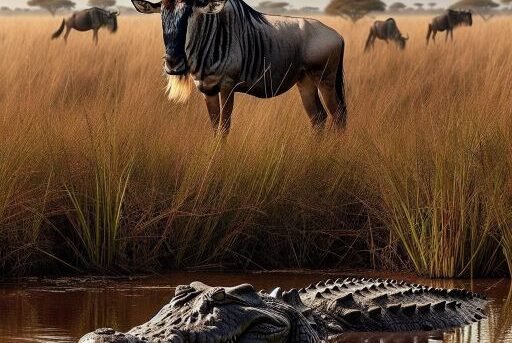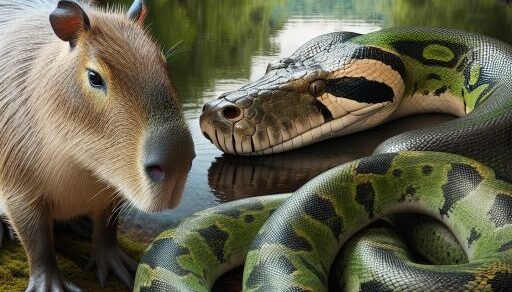Location and Habitat
The wildebeest, also known as the gnu, is predominantly found in the grassy plains and open woodlands of central, southern, and eastern Africa, particularly thriving in the Serengeti in Tanzania and the Masai Mara in Kenya. These regions provide the ideal habitat for these migratory animals, offering abundant grass for grazing and water sources essential for their survival during their annual migration.
On the other hand, the Nile crocodile is widely distributed across sub-Saharan Africa, inhabiting a variety of freshwater environments such as rivers, lakes, and marshlands. These formidable reptiles are particularly prevalent along the Nile River, from which they derive their name. Adapted to a life in and around water, Nile crocodiles are excellent swimmers and rely on the aquatic habitats not only for hunting but also for breeding, with riverbanks often used as nesting sites.
Wildebeest vs. Nile Crocodile Comparison
| Animal | Size and Weight | Ability to Finish Opponent | Weaponry |
|---|---|---|---|
| Wildebeest | 1.3 to 1.5 meters at the shoulder; 120 to 270 kg | Low; primarily defensive, can use horns and hooves | Horns and strong hooves |
| Nile Crocodile | Up to 5 meters long; 225 to 750 kg | High; excellent predator with strong bite force | Powerful jaws, sharp teeth, strong tail |
Hunting and Skills
Wildebeests, primarily grazers, often fall prey to predators like lions, hyenas, and cheetahs, especially during their annual migration across rivers where Nile crocodiles await. These crocodiles, adept ambush predators, rely on the element of surprise to capture prey such as fish, zebras, small hippos, and birds. They use their powerful jaws to grab and drag their prey underwater, utilizing a death roll to disorient and drown the victim. Wildebeests defend themselves by forming large herds to reduce individual risk and use their numbers and agility to escape predators, though they are less effective against the stealth and sudden attacks of crocodiles in water.
Wildebeest vs. Nile Crocodile Who Would Win?
The wildebeest approaches the water to drink. The Nile crocodile waits submerged near the edge. As the wildebeest leans down, the crocodile lunges, aiming to clamp its jaws on the wildebeest’s snout or leg. The wildebeest attempts to escape, struggling fiercely. If on land, the wildebeest might break free due to its strength and speed. If dragged into deeper water, the crocodile has the advantage and likely drowns the wildebeest. Winner: Nile Crocodile with a 80% chance of winning.
Important Points
Key points to consider in a Wildebeest vs. Nile Crocodile fight:
Nile Crocodile Advantages:
- Apex Predator: Nile Crocodiles are ambush predators perfectly adapted for hunting in water.
- Power and Bite Force: Their massive size, powerful jaws, and sharp teeth can crush bones and overpower large prey.
- Camouflage: They blend in almost seamlessly with water, making them difficult to spot for wildebeest.
Wildebeest Advantages:
- Strength and Speed: Wildebeest are large herbivores with surprising strength and speed, especially on land.
- Numbers: They migrate in massive herds, making it difficult for a crocodile to pick a target.
- Herding Behavior: They may group together to form a protective wall against crocodiles when crossing rivers.
Fight Outcome:
- In Water: Nile Crocodile has a clear advantage. Their power and aquatic agility make them deadly to wildebeest in the water.
- On Land: Wildebeest have a better chance. Their strength and speed can deter a crocodile attack.
Additional factors:
- Location of Encounter: If a wildebeest needs to cross crocodile-infested water, it becomes much more vulnerable.
- Wildebeest Herd: A large, tightly packed herd can make it harder for a crocodile to single out prey.
- Crocodile Size: A smaller crocodile might struggle with a large, healthy wildebeest.
Generally:
The Nile Crocodile poses a significant threat to wildebeest, especially during the migration when they cross rivers. However, wildebeest use their strength, numbers, and staying on land whenever possible to increase their chances of survival.




